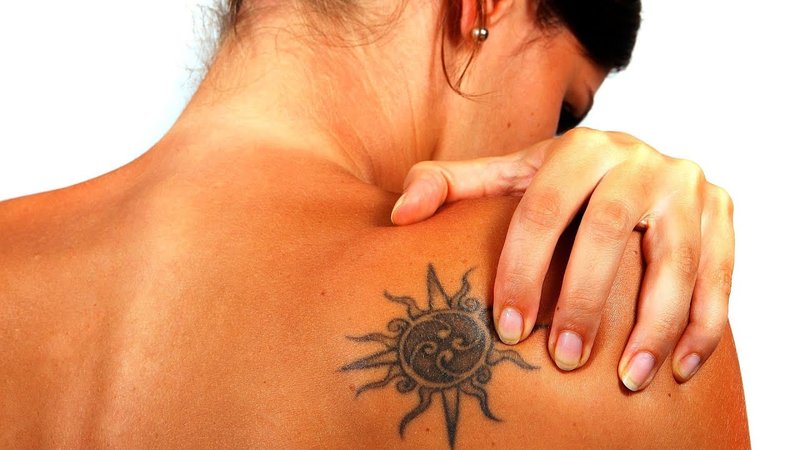
One of the most important issues that concerns everyone who decided on a tattoo is what to do after applying a tattoo. If everything seems clear with the choice of sketch and place of application, few people guess what to do after for proper healing of the picture.
General Tattoo Care Tips

Deciding to get a tattoo, first of all, you need to realize the importance of the recommendations after applying the tattoo. If there is no time and opportunity to pay regular attention (several times a day) to a drawing, then you should wait for better times.
For those who are not afraid of regular two-week cares about a tattoo, it should be clear that it is especially important to monitor the tattoo in the early days. However, the drawing requires care in the future.
There are also general recommendations for the entire healing period of a tattoo:
- Flush the pattern regularly;
- Use only the products intended for processing;
- Wear loose clothing so that it does not come into contact with the tattoo;
- Do not pinch the tattoo with bandages, cloth or clothing;
- Keep the tattoo hydrated.
You also need to familiarize yourself with individual recommendations regarding tattoo care, which should be voiced by the master. In some cases, masters issue special reminders for the care of the pattern. But the instructions are not always divided into stages of care in the first days and subsequent, and this nuance is extremely important.
How to handle a tattoo in the first days after application

The opinion that the master wraps a film with his hand for the benefit and this should be done regularly independently, is wrong. In fact, the film is applied literally for 2-8 hours to protect the fresh tattoo from dust and dirt. The main tattoo care in the first days after applying the film begins with its removal.
On the first day of tattooing you need:
- After 2-8 hours, remove the film, rinse with water at room temperature and antibacterial soap;
- Lubricate the drawing with a special ointment (preferably prescribed by the master);
- Rinse the tattoo every 3-4 hours according to the same principle;
- Each time after washing, apply ointment;
- Do not wrap or seal the tattoo.
An important rule: it is necessary to apply ointment to the tattoo, the use of a spray or gel slows down the healing process.
In the early days of tattoo care, you need to consider the type of film with which the master protected the drawing. There are ordinary food and Supraforb F. films. When using a simple film, the rules of care are the same for all days. When using Supraforb F there are additional nuances.
When fixing a Supraforb F tattoo you need to know:
- The film is not removed for 4 days, only 5 after applying the tattoo;
- In the film, it is allowed to take a shower, but not for long;
- You can remove Supraforb F by heating the film, for example, using a hairdryer;
- Tattoos are washed with water and liquid soap;
- Then grease the picture every 3-4 hours with ointment.
Another important nuance is that after each tattoo wash, the drawing should be gently patted with a towel and allowed to dry. Do not rub dry with a cloth.
Drawing care in the later stages of healing

Properly care for the tattoo on the arm or other part of the body should be in the following days. Usually, the healing period is extended over two weeks. What to expect at this time:
- Skin peeling;
- Uneven coloring of the picture;
- The possible appearance of bulges and tubercles;
- Sensations of itching in the area of the picture.
The most dangerous is peeling. But it is dangerous not for health, but for the quality of the tattoo. Peeling and itching are the most common reason why many, without hesitation, tear off the outgoing areas of keratinized skin along with the pattern. As a result, a tattoo can turn out with empty areas.

To avoid losing the quality of the tattoo, you need:
- Flush the tattoo regularly as directed;
- Lubricate the tattoo with ointment;
- Avoid drying out this area of the skin.
To avoid overdrying the skin, many masters recommend using a special tonic that needs to get a tattoo wet between the wash and applying the ointment.
The lotion should be water-based, alcohol free.
Keeping your tattoo wet should be done for a week, but it’s quite individual. Therefore, before applying the lotion, it is better to ask the master if there is a need for the lotion.
Contraindications for tattoo care

Along with recommendations for caring for a tattoo, there are a number of contraindications. This is mainly due to the fact that many are unaware of the harm that can be caused to the picture by the simplest actions.
After applying the tattoo you can not:
- Steaming a tattoo, visiting saunas and a solarium;
- Engage in active sports;
- Avoid prolonged stay in a hot bath (not more than 10 minutes);
- Allow contact with chlorinated water (pool) or salt (sea);
- Scratch and scratch the place of drawing, rub with a washcloth;
- Drinking alcohol.
Moreover, you can not wrap the tattoo with film or bandages.
When the skin for a long time is under a kind of tight protection, the greenhouse effect is triggered, thus creating a favorable environment for bacteria.
It is important to take into account that tight clothing that fits tightly on the tattoo and creates friction on the pattern can lead to a pale pale tattoo in the future.
Top best ointments for tattoo processing

Usually, at the end of the tattoo session, the masters say how to process the tattoo after application. The most popular option recommended by most masters is Bepanten ointment with a moisturizing and soothing effect.
The main rule when choosing an ointment is the presence of a base in the form of dexapanthenol.
There are other options for ointments, among which the best can be distinguished:
- Bepanten - an ointment that does not cause allergies and delays the appearance of crusts;
- Panthenol is a spray intended for burns, but also excellent for the care of injured skin. You can use up to 4 times a day;
- Pantestin - an antibacterial and antifungal ointment for affected skin;
- Traumeel C is an ointment with an anti-inflammatory effect that can be used only after treatment of the tattoo area with chlorhexidine;
- Solcoseryl - gel and ointment, and first a thin layer of gel is used and only after that is the ointment applied.
After ointments, you can go to more gentle options for treating the tattoo area. This happens approximately a week after applying the tattoo. Basically, the ointment is replaced with medical vaseline without additives and odor.
There are tattoo vaccines - special ointments based on essential oils that heal wounds well.
The following ointments are not recommended:
- Syntomycin;
- Levomekol.
In rare cases, and with severe itching, it is allowed to apply a compress with Sinaflan ointment once (no more than two) per day, which is a good antiseptic.After applying the tattoo with chlorhexidine, you can apply a compress to dry skin.
The consequences of improper tattoo care

You need to take care of the tattoo correctly, otherwise you can get a poor-quality tattoo and even health problems. But you need to distinguish the normal skin reaction to a tattoo from the adverse effects.
Do not be afraid withear, redness, irregularities, swelling, bruising, peeling of the skin and allocation of anemia.
Symptoms that may indicate impaired healing of the tattoo are mainly expressed in the appearance of pus and an unpleasant odor in the area of the picture. They also include the appearance of watery abscesses, a rash, and the spread of hematoma to other areas of the skin.
The consequences of improper tattoo care:
- Infection in the body;
- Blood poisoning;
- Keloid scars;
- Abscesses on the skin.
People suffering from allergic reactions need to be extremely careful. There is a possibility that there will be an allergy to the paint, and this can provoke complications during healing.
In any case, before deciding to apply a tattoo, you need to consider that the process of getting rid of it is quite complicated, long and painful.






























